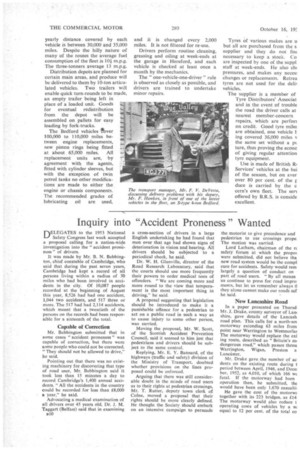Inquiry into "Accident Proneness" Wanted
Page 44

If you've noticed an error in this article please click here to report it so we can fix it.
DELEGATES to the 1953 National Safety Congress last week accepted a proposal calling for a nation-wide investigation into the "accident proneness" of drivers.
It was made by Mr. B. N. Bebbington, chief constable of Cambridge, who said that during the past seven years, Cambridge had kept a record of all persons living within a radius of 30 miles who had been involved in accidents in the city. Of 10,087 people recorded at the beginning of August this year, 8,526 had had one accident, 1,044 two accidents, and 517 three or more. The 517 had had 2,114 accidents, which meant that a twentieth of the persons on the records had been responsible for a sixteenth of the total.
Capable of Correction Mr. Bebbington submitted that in some cases "accident proneness" was capable of correction, but there were some people who could not be corrected. "They should not be allowed to drive," he said.
Pointing out that there was no existing machinery for discovering that type of road user, Mr. Bebbington said it took less than 15 minutes a day to record Cambridge's 1,400 annual accidents. "All the accidents in the country could be recorded for less than £8,000 a year," he said.
Advocating a medical examination of all drivers over 45 years old, Dr. J. M. Taggart (Belfast) said that in examining 1 0
a cross-section of drivers in a large English undertaking he had found that men over that age had shown signs of deterioration in vision and hearing. All drivers should be subjected to a periodical check, he said.
Dr. W. H. Glanville, director of the Road Research Laboratory, said that the courts should use more frequently their powers to order medical tests of offenders. "We are coming more and more round to the view that temperament is the most important thing in driving," he said.
A proposal suggesting that legislation should be introduced to make it a punishable offence for a pedestrian to act on a public road in such a way as to cause injury to some other person, was carried.
Moving the proposal, Mr. W. Scott, of the Scottish Accident Prevention Council, said it seemed to him just that pedestrians and drivers should be subject to the same control.
Replying, Mr. E. Y. Bannard, of the highways (traffic and safety) division of the Ministry of Transport, doubted whether provisions on the lines proposed could be enforced.
Arguing that there was still considerable doubt in the minds of road users as to their rights at pedestrian crossings, Mr, T. Rutter, deputy town clerk of Colne, moved a proposal that their rights should be more clearly defined. He thought the Society should embark on an intensive campaign to persuade the motorist to give precedence and pedestrian to use crossings propei The motion was carried.
Lord Latham, chairman of the rc safety forum at which the propos were submitted, did not believe tha new road system would be the compl cure for accidents. Safety would rem largely a question of conduct on part of road users. "By all means US continue to press for road impro ments, but let us remember always tl they alone cannot make our roads saf he said.
New Lancashire Road
In a paper presented on Thursd: Mr. J. Drake, county surveyor of Lam shire, gave details of the Lancash road plan. This calls for a north-sot motorway extending 63 miles from point near Warrington to Westmorlai The motorway would replace the exi ing route, described as "Britain's mi dangerous road," which passes throu Warrington, Wigan, Preston a Lancaster.
Mr. Drake gave .the number of ac dents on the existing route during I period between April, 1946, and Deco her, 1952, as 4,010, of which 166 we fatal. If the motorway had been operation then, he submitted, the would have been only 1,670 casualti.
He gave the cost of the motorws together with its 223 bridges. as £14: The motorway would also reduce t operating costs of vehicles by a su equal to 12 per cent, of the total co




























































































